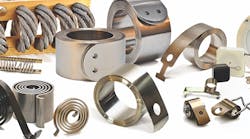Spring are mechanical devices that store and apply kinetic energy. They’ve been around a long time and continue to play essential roles in a wide range of machines, vehicles, and engineering tools. But with so many different types of springs to choose from, it is important engineers understand what an application will require a spring to do before selecting the best one for that application. They also need to consider how springs will interact with other components.
Here are some issues engineers need to consider in the design phase to help guide spring selection.
Sizing. The size of a spring can vary greatly depending on its use, ranging from industrial applications to micro sizes for medical devices. Several considerations go into determining the best size for an application.
Major factors to account for include the size and weight of the intended load, the mounting location, and how far the spring needs to travel. It is important to have enough room, but also not to have a spring that is too short. There should be a stop that prevents the spring from excessive deflection, which can cause damage and increased wear.
Environmental factors. Designers must account for environmental factors that might affect function. Adapting to various environments can mean adjusting the size, material, or placement of the spring.
Corrosion is an ordinary risk for many materials. It causes metals to degrade and lose structural integrity. Although outdoor exposure is a common source of corrosion, other environments also pose risks. Some indoor environments, for example, have high rates of condensation, which hastens corrosion. Corrosive chemicals are another set of risks.
A variety of protective finishes protect springs from corrosion. Assessing the risk and balancing protection requirements with potential effects on the intended function can help in selecting the best material and finishes.
Vibrations also damage springs. This risk is especially prevalent in industrial settings but can also happen in medical and dental equipment. If this is a concern, explore vibration protection options such as helical vibration isolators.
Temperature. Temperature extremes damage springs or impair their operation. Choosing the right material, such as high-grade stainless steel, increases temperature resistance. Spring materials also experience different effects from extreme temperatures, depending on the load on the spring. Typically, high loads decrease temperature resistance. Springs made of high-grade stainless steel withstand higher temperatures.
Materials. The most common materials for standard springs are music wire and Grade 302 stainless steel. These materials may not stand up well under high temperatures and/or high loads. Other grades of stainless steel can deliver better performance. Manufacturers also make springs out of various proprietary alloys for specific applications.
Grade 302 stainless steel resists corrosion and chemical damage, which makes it a good option for medical, laboratory, and some types of industrial environments. It does not, however, possess outstanding temperature resistance. Its specifications generally indicate an upper limit of 550 F, but this number can decrease if there is also significant load.
Grade 17-7 stainless steel has a higher level of temperature resistance at 650°F. It is also highly durable and resists corrosion and deformation. Common applications include automobile manufacture, energy, and gas and oil. For some of these, you may also want to add an additional protective coating.
Chrome silicon springs are durable and have a high level of tensile strength. This makes them a good choice for high-impact and/or high load applications such as weapons manufacture. Although this alloy works well in a fairly wide range of temperatures, it is not the best choice for extremely high temperatures.
Inconel alloys are used to create springs that need to function in extreme environments. Some types of Inconel alloys resist corrosion and temperatures of up to 1,300°F. Inconel springs are used in aerospace and nuclear energy.
Springs made of high-quality materials generally cost more, but depending on the application, such material may be required.
Stock vs. custom. The advantage of stock springs is obvious: You can typically get them right away and they cost less than custom springs. Many manufacturers offer a wide range of stock springs and components, so if you can find one that matches your specifications, this is a good option. Stock springs also offer a quick, cost-effective way to build and test prototypes.
However, working with a manufacturer on a custom order is the best way to ensure you get a mechanical component that is a best fit for your application the first time. Although the process can take time, customized springs can help you get precise measurements, as well as the right materials and protective finishes. This can be crucial if your project has a tight deadline and budget.
Making the right choice means weighing several design factors, including the intended use, cost, and project timeframe. Note that decisions about these design factors will affect overall project cost. Look for a manufacturer that has extensive design engineering knowledge and capabilities to help guide you during the design phase of your project.
Edward Jones is the marketing manager of John Evans’ Sons, a leading company in designing and manufacturing constant force springs, constant force spring assemblies, and pusher springs (variable force).

